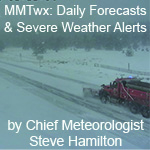- Posts: 50
- Thank you received: 0
Sand colic
- Shannon Harland-DVM
-
 Topic Author
Topic Author
- Happy Camper
-

Less
More
22 Mar 2011 12:09 #1
by Shannon Harland-DVM
Sand colic was created by Shannon Harland-DVM
Colic is a problem that many horse owners face at some point. There are many different causes of colic, one of which is sand ingestion.
Horses ingest sand from eating off the ground and the amount is dependent on the environment where the horse lives. Certain areas have soil that is higher in sand or silt. As the sand is ingested if it is not passed out in manure at the same rate, it can accumulate in the colon. As it accumulates the combination of the weight and irritation effect of the sand cause decreased intestinal motility, and absorption of water and nutrients.
Whether a horse accumulates sand is also dependent on the horse itself and its management. Some horses seem to just be prone to accumulating sand. In these cases there may be multiple horses in an area and only one will have a problem with sand. Whether this is due to inherent motility problems or that horse enjoys browsing around on the ground more than the others can be hard to tell.
Signs of a sand problem in a horse can vary. They can include intermittent loose manure, unexplained weight loss or unthriftiness, or colic. Colic usually occurs when a larger amount of sand has accumulated in the intestine. The weight of the sand and the irritation to the colon can cause low grade colic, or if the sand accumulates enough to form a firm blockage a more serious colic will result. Occasionally a horse will have no signs and sand is found on routine examination.
There are a few ways to determine if a horse has sand. Veterinarians can sometimes hear sand moving in the colon when they listen to the lowest part of the belly. It has a distinctive “whooshing” sound and occasionally sounds like a beach. But if the sand is compacted or the horse had decreased motility, it can’t be heard. One of the easiest ways to determine if a horse is passing sand is by doing a manure floatation test, which can be done by owners at home. With this test fresh manure is collected (from the top of the manure pile so not to pick up dirt from the ground possibly giving false positive results!) and mixed with equal amounts water in a container or plastic bag. The mixture is allowed to settle for an hour or so and any sand in the manure will settle to the bottom of the container or bag. The main limitation with this test is that if the horse has sand but is not passing it in its manure then the test will be negative, if a moderate or large amount of sand is found, then the horse definitely has a problem.
If a horse is colicky and suspected to have sand but it cannot be proven, a radiograph of the abdomen can be taken since the sand is dense enough to show up on X-rays. However specialized equipment is needed so this is only offered at large hospitals.
Treatment of sand ingestion partly involves treating the horse and managing the environment. For horses that are not colicky, it is recommended starting them on a supplement called psyllium. It is similar to Metamucil for people and when ingested it absorbs water to form a gel-like substance that helps remove the sand. There are many different brands and formulations on the market and all are probably similar in effectiveness. It often depends on whether a horse prefers powder or pellets and overall cost. There is a recommended dose on the package, but a veterinarian may recommend a different dosage or regime depending on the severity of the sand accumulation. If a horse is colicky due to sand the treatment depends on the severity of the colic and the amount of sand in the horse. Mild colics usually respond to pain management and stomach tubing with large amounts of psyllium and mineral oil to remove the sand, occasionally if the horse becomes dehydrated IV fluids are necessary. If the horse has a large amount of sand or the sand is firmly compacted surgery may be necessary to empty the large intestine. Occasionally there are cases of horses rupturing their colon if they have severe sand accumulation.
Management is the most important part to prevent the horse from ingesting sand in the first place. This means feeding in feeders or tubs and placing rubber mats on the ground where the horse eats. If the horse is on pasture, try to prevent overgrazing. Feeding hay is important because it maintains normal gut motility and the high fiber helps to move sand through. If the horse is eating dirt due to boredom or mineral imbalance offering toys or a salt lick may help. If despite the above precautions a horse is still accumulating sand, sometimes a change in environment is needed.
If you have any questions about whether your horse may have sand or what to do about it please feel free contact me or your regular veterinarian.
Horses ingest sand from eating off the ground and the amount is dependent on the environment where the horse lives. Certain areas have soil that is higher in sand or silt. As the sand is ingested if it is not passed out in manure at the same rate, it can accumulate in the colon. As it accumulates the combination of the weight and irritation effect of the sand cause decreased intestinal motility, and absorption of water and nutrients.
Whether a horse accumulates sand is also dependent on the horse itself and its management. Some horses seem to just be prone to accumulating sand. In these cases there may be multiple horses in an area and only one will have a problem with sand. Whether this is due to inherent motility problems or that horse enjoys browsing around on the ground more than the others can be hard to tell.
Signs of a sand problem in a horse can vary. They can include intermittent loose manure, unexplained weight loss or unthriftiness, or colic. Colic usually occurs when a larger amount of sand has accumulated in the intestine. The weight of the sand and the irritation to the colon can cause low grade colic, or if the sand accumulates enough to form a firm blockage a more serious colic will result. Occasionally a horse will have no signs and sand is found on routine examination.
There are a few ways to determine if a horse has sand. Veterinarians can sometimes hear sand moving in the colon when they listen to the lowest part of the belly. It has a distinctive “whooshing” sound and occasionally sounds like a beach. But if the sand is compacted or the horse had decreased motility, it can’t be heard. One of the easiest ways to determine if a horse is passing sand is by doing a manure floatation test, which can be done by owners at home. With this test fresh manure is collected (from the top of the manure pile so not to pick up dirt from the ground possibly giving false positive results!) and mixed with equal amounts water in a container or plastic bag. The mixture is allowed to settle for an hour or so and any sand in the manure will settle to the bottom of the container or bag. The main limitation with this test is that if the horse has sand but is not passing it in its manure then the test will be negative, if a moderate or large amount of sand is found, then the horse definitely has a problem.
If a horse is colicky and suspected to have sand but it cannot be proven, a radiograph of the abdomen can be taken since the sand is dense enough to show up on X-rays. However specialized equipment is needed so this is only offered at large hospitals.
Treatment of sand ingestion partly involves treating the horse and managing the environment. For horses that are not colicky, it is recommended starting them on a supplement called psyllium. It is similar to Metamucil for people and when ingested it absorbs water to form a gel-like substance that helps remove the sand. There are many different brands and formulations on the market and all are probably similar in effectiveness. It often depends on whether a horse prefers powder or pellets and overall cost. There is a recommended dose on the package, but a veterinarian may recommend a different dosage or regime depending on the severity of the sand accumulation. If a horse is colicky due to sand the treatment depends on the severity of the colic and the amount of sand in the horse. Mild colics usually respond to pain management and stomach tubing with large amounts of psyllium and mineral oil to remove the sand, occasionally if the horse becomes dehydrated IV fluids are necessary. If the horse has a large amount of sand or the sand is firmly compacted surgery may be necessary to empty the large intestine. Occasionally there are cases of horses rupturing their colon if they have severe sand accumulation.
Management is the most important part to prevent the horse from ingesting sand in the first place. This means feeding in feeders or tubs and placing rubber mats on the ground where the horse eats. If the horse is on pasture, try to prevent overgrazing. Feeding hay is important because it maintains normal gut motility and the high fiber helps to move sand through. If the horse is eating dirt due to boredom or mineral imbalance offering toys or a salt lick may help. If despite the above precautions a horse is still accumulating sand, sometimes a change in environment is needed.
If you have any questions about whether your horse may have sand or what to do about it please feel free contact me or your regular veterinarian.
Please Log in or Create an account to join the conversation.
Time to create page: 0.119 seconds






